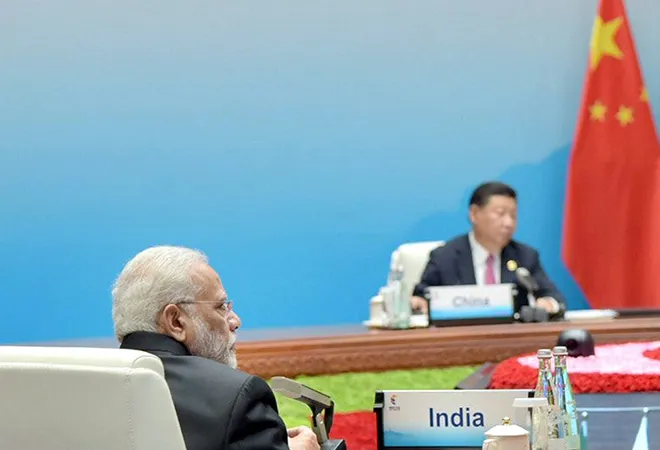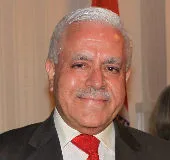
Before the start of the 9th BRICS Summit in Xiamen, China, no one in the Indian foreign policy or security establishment could have estimated that its outcome could be as encouraging and reassuring from the Indian perspective as it ultimately turned out to be. In fact, even 10 days before the start of the summit on 3 September, it was not confirmed whether Prime Minister Narendra Modi will travel to China to participate in the summit. This was one of the significant reasons for China to agree to disengage from Doklam on 28 August and suspend construction of the road on the plateau. The dignified and restrained manner in which India conducted itself during the 73 day long crisis in comparison with the shrill, vituperative rhetoric emanating from China did much to enhance the political stature of India, and of Prime Minister Modi. Modi hence went to Xiamen as a confident, strong leader with considerable sangfroid and aplomb.
The days preceding the summit were not without anxiety. Spokesperson of the Chinese Foreign Office said two days before the summit that India should not raise the issue of terrorism and criticise Pakistan because this would not be the appropriate forum to discuss this subject. In a rebuttal, on being asked, the Indian Foreign Office said that the Indian PM will definitely raise the issue of terrorism as this is a scourge that is increasingly afflicting the world. Just a day prior to the summit, delivering a speech at the opening ceremony of the BRICS Business Forum, Chinese President Xi Jinping called on BRICS countries to adopt a holistic approach to fight terrorism in all its forms and address both its "symptoms and root causes" so that terrorists will have no place to hide. This formulation appears to have been taken by China from the Pakistani lexicon as Pakistan constantly uses this phraseology to imply that people in Kashmir have been forced to take up arms because of so called oppression of Indian security forces.
In this background, the formulation on the issue of terrorism appearing in the BRICS Declaration on 4 September is nothing short of remarkable. The achievement becomes all the more impressive if it is compared with the formulation on the issue that appeared in the Goa Declaration at the end of the 8th BRICS Summit on 16 October 2016. In the run-up to the last summit, Modi had severely chastised Pakistan for its terrorist activities against India and in other parts of the world and termed it as the "mothership of terrorism". China (and Russia) had fought hard to keep any reference to crossborder terrorism or to Pakistan-based terrorist groups out of the summit declaration. In fact, China mentioned terrorism along with natural and manmade disasters in its plenary statement. Russia did not make any reference to the 'T' word in its statement. In comparison, the hard-hitting language against terrorism and specific mention of Pak-based terrorist groups like Lashkar-e-Taiba (LeT), Jaish-e-Mohammad (JeM) and others like Taliban, Haqqani Network etc., is nothing but exceptional.
The formulation on the issue of terrorism appearing in the BRICS Declaration on 4 September is nothing short of remarkable.
Some analysts have sought to diminish the significance of this inclusion by saying that this is nothing new because reference to these terror groups was made in the Heart of Asia Declaration in Amritsar on 4 December 2016 at which representatives of China and Pakistan were present. What sets this declaration apart however is that this was adopted on the Chinese soil at the level of the Chinese President and not at the level of some ministers or senior officials.
Some other commentators have tried to bring down the impact of this development by contending that the term terrorist organisation has not been used for these groups and what has been criticised is the "violence" committed by these organisations. This appears to be splitting hairs. Paragraph 48 in which these groups are mentioned needs to be read in conjunction with the preceding and the following paras, all of which speak about the necessity of joint action against terrorist forces. Moreover, in addition to terrorist cliques like LeT, JeM, Taliban, etc., which are active against India and Afghanistan, reference has also been made to factions like East Turkistan Islamic Movement and Islamic Movement of Uzbekistan which are based in Central Asia and act against China. China has maintained in several fora that these are terrorist gangs which act against China's security, stability and integrity.
Significance of specific mention of these groups can be judged from the fact that on the very next day after the declaration was issued, Pakistan Foreign Office categorically rejected the declaration and said that no terrorist groups are based on its territory. The remarkable speed with which Pakistan took cognizance of this document and condemned it is amusing because the name of Pakistan does not appear anywhere in the declaration. Better sense however appears to have prevailed in some sections of the Pakistan establishment when on 6 September, its Foreign Minister acknowledged that Pakistan needs to curtail the activities of LeT and JeM and remarked that it should not be constantly putting its friends like China to the test. It would be recalled that Pakistan had vehemently rejected the accusation by US President Donald Trump during his articulation of the South Asia Strategy on 21 August when he warned Pakistan against providing safe havens and shelter to terrorist groups like Let, JeM etc. Pakistan would have then apparently thought that its "iron brother" China would bail it out in future as is has done in the past. Pakistan would have had in mind the unflagging support of China in keeping the Jaish mastermind Masood Azhar from being designated a terrorist by the United Nations. In recent months, China has used the instrument of its veto and technical hold to save Pakistan from this eventuality. It had however become quite clear that China's patience was wearing thin and it was finding the pressure from the international community insufferable and had advised Pakistan to have a relook at its support to these terror groups. In a celebrated leak case, a renowned columnist Cyril Almeida had contributed a front page story to Dawn newspaper of Pakistan on 6 October 2016 about a rift between civilian and military leaderships over militant groups that operate from Pakistan, but engage in proxy wars against India and Afghanistan. In this, he stated that the then Foreign Secretary Aizaz Ahmed Chaudhary had suggetsed: "hile China has reiterated its support for Pakistan, it too has indicated a preference for a change in course by Pakistan. Specifically, while Chinese authorities have conveyed their willingness to keep putting on technical hold a UN ban on Jaish-i-Mohammad leader Masood Azhar, they have questioned the logic of doing so repeatedly."
China's patience was wearing thin. It was finding the pressure from the international community insufferable and had advised Pakistan to have a relook at its support to terror groups.
It would appear that China would have found itself under intolerable pressure and would have given in to including names of Pak-based terror groups in the Declaration. This can be seen as an unanticipated but huge political, moral and diplomatic achievement for India. Coming in the wake of the diplomatic success in Doklam, this has given a further boost to the image, clout and prestige of the country as well as its leadership.
Bilateral meeting between Prime Minister Modi and President Xi turned out to be equally consequential. They tried to put the unhappy experience of Doklam behind them and to enhance the level of trust between the two countries. Atmospherics might have been a little tense to begin with, but the final outcome was satisfying and encouraging. In his briefing to the media after the meeting, Foreign Secretary Jaishankar said that the two leaders had focussed on a forward looking approach and tried to ensure that incidents of the sort that had happened in the recent past do not recur. In this context, defence and security personnel of the two countries will be advised to maintain more active and frequent contacts with each other. Both sides reiterated the "Astana Consensus" that "disagreements" should not be allowed to become ’’disputes’’. PM Modi appears to have clearly informed his counterpart that maintenance of peace and tranquility on the border is a sine qua non if full potential of bilateral relations is to be achieved. Both leaders agreed that in this uncertain world, relations between India and China should be a factor of stability.
Modi and Xi tried to remove cobwebs and mistrust that have appeared in bilateral ties recently. It will, however, take much more than a single meeting between the two leaders to restore the same kind of working relationship between the two countries that has existed for the last 30 years. China has to blame itself for this state of affairs as this is the direct result of the insults, threats and indignities heaped by it on India. On the contrary, India's conduct during the Doklam standoff was calm but firm and steadfast. India will need to be wary and alert about China's actions and intentions. Its pronouncements cannot be taken at face value. India will need to improve its infrastructure, particularly in the border areas, and also its defence preparedness. India needs to focus on its economy and improve its national comprehensive strength.
There are opportunities for India to cooperate with China in the area of getting more investment and upgradation of its infrastructure.
There are opportunities for India to cooperate with China in the area of getting more investment and upgradation of its infrastructure. However, India needs to be cautious in sensitive sectors like power, telecommunications, cyber security etc. China needs to be pressurised to open its market to Indian goods. The current trade imbalance of USD 50 billion in favour of China is unsustainable. In global governance, on issues like Climate Change, WTO etc., there are possibilities of cooperation and should be fully utilised.
India should, however, not let its guard down and be ready to protect its interests whether territorial, trade, business, strategic, political, etc. in every way. Care should be exercised so that competition does not transform into confrontaion. It is in the interest of neither country to have antagoniostic relations with the other. India is keen to have cordial and mutually beneficial relations with China. This message has been conveyed loud and clear to China starting with the first visit by Xi Jinping to India in September 2014. China will need to deal with India with respect and as an equal if mutually beneficial and advantageous outcome is to be achieved.
The views expressed above belong to the author(s). ORF research and analyses now available on Telegram! Click here to access our curated content — blogs, longforms and interviews.




 PREV
PREV


